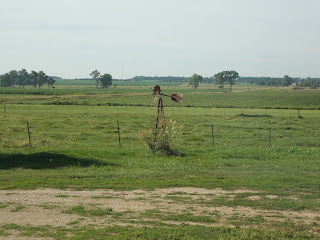I returned home from a thirteen-day holiday early on Saturday morning. During the second week, when I was in South Dakota, I wrote a bit everyday, whether it was emails or journaling or brainstorming on the Regency novel that my friend Laura and I are writing. It wasn’t nearly as much writing as I normally do. But it was a perfect break, because all the out-of-the-ordinary things I experienced filled my inspiration up to the brim and I’ve been yearning to get back to my writing life.
There’s several things I could write blog posts about -- where to start? Perhaps the most exciting, interesting subject to a literary blog … my visit to the world of Laura Ingalls Wilder’s books By the Shores of Silver Lake, The Long Winter, Little Town on the Prairie, These Happy, Golden Years, and The First Four Years. I thought I was a fan before, but after I visited De Smet, South Dakota, where the Ingalls family lived from 1879 on, I’m aflame for the Little House books and Laura Ingalls Wilder’s life.
There’s nothing like seeing the real setting of history or stories you love. I don’t recall what I pictured when my mom and I read the Little House series years ago, but it wasn’t quite what I saw last week. I anticipate reading the books again with my new perspective!
I saw the Big Slough where Laura and Carrie got lost in the beginning of The Long Winter. That was my first glimpse of Laura’s land, and it delighted me to no end. Look how tall the grass is! It swallowed them easily. No wonder Ma was always afraid little Grace would wander into it.
There’s several things I could write blog posts about -- where to start? Perhaps the most exciting, interesting subject to a literary blog … my visit to the world of Laura Ingalls Wilder’s books By the Shores of Silver Lake, The Long Winter, Little Town on the Prairie, These Happy, Golden Years, and The First Four Years. I thought I was a fan before, but after I visited De Smet, South Dakota, where the Ingalls family lived from 1879 on, I’m aflame for the Little House books and Laura Ingalls Wilder’s life.
There’s nothing like seeing the real setting of history or stories you love. I don’t recall what I pictured when my mom and I read the Little House series years ago, but it wasn’t quite what I saw last week. I anticipate reading the books again with my new perspective!
I saw the Big Slough where Laura and Carrie got lost in the beginning of The Long Winter. That was my first glimpse of Laura’s land, and it delighted me to no end. Look how tall the grass is! It swallowed them easily. No wonder Ma was always afraid little Grace would wander into it.

Did you know “slough" is pronounced “sloo"?
“So they did not follow the road that turned to cross the slough. They went straight on into the tall slough grass.
“At first it was fun. It was rather like going into the jungle-picture in Pa’s big green book. Laura pushed ahead between the thick clumps of grass-stems that gave way rustling and closed again behind Carrie. The millions of coarse grass-stems and their slender long leaves were greeny-gold and golden-green in their own shade. The earth was crackled with dryness underfoot, but a faint smell of damp lay under the hot smell of the grass. Just above Laura’s head the grass-tops swished in the wind, but down at their roots was a stillness, broken only where Laura and Carrie went wading through it.” (The Long Winter)
Silver Lake itself has been drained, but all over that area of South Dakota are little round, glassy lakes that must have been very similar.
“The lake lay at their left shimmering in the sunshine. Little silvery waves rose and fell and lapped upon the shore as the wind ruffled the blue water. The shore was low, but firm and dry, with little grasses growing to the water’s edge. Across the glittering lake, Laura could see the east bank and the south bank, rising up as tall as she was. A little slough came into the lake from the northeast, and Big Slough went on toward the southwest in a long curve of tall wild grasses.” (By the Shores of Silver Lake)
Eastern South Dakota is similar to Minnesota, which is called the Land of Ten Thousand Lakes. Being from Texas, the small, full bodies of water dotting the prairie was a novelty. Now I know why Laura mentioned so many lakes in her books and why she wrote so often of Silver Lake and the Big Slough. It’s beautiful! Here are some more images of the South Dakota prairie:
On a side note, don’t you just love the simple, warm, yet descriptive way in which Laura Ingalls Wilder writes? Writers describing their homeland are often at their best!
Stay tuned for Part 2 of my Little Town on the Prairie adventures.







